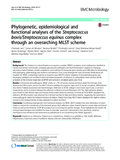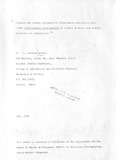| dc.contributor.author | Jans, Christoph | |
| dc.contributor.author | de Wouters, Tomas | |
| dc.contributor.author | Bonfoh, Bassirou | |
| dc.contributor.author | Lacroix, Christophe | |
| dc.contributor.author | Kaindi, Dasel WM | |
| dc.contributor.author | Anderegg, Janine | |
| dc.contributor.author | Böck, Désirée | |
| dc.contributor.author | Vitali, Sabrina | |
| dc.contributor.author | Schmid, Thomas | |
| dc.contributor.author | Isenring, Julia | |
| dc.contributor.author | Kurt, Fabienne | |
| dc.contributor.author | Kogi-Makau, Wambui | |
| dc.contributor.author | Meile, Leo | |
| dc.date.accessioned | 2017-04-03T09:37:33Z | |
| dc.date.available | 2017-04-03T09:37:33Z | |
| dc.date.issued | 2016 | |
| dc.identifier.citation | Jans, C., de Wouters, T., Bonfoh, B., Lacroix, C., Kaindi, D. W. M., Anderegg, J., ... & Kurt, F. (2016). Phylogenetic, epidemiological and functional analyses of the Streptococcus bovis/Streptococcus equinus complex through an overarching MLST scheme. BMC microbiology, 16(1), 117. | en_US |
| dc.identifier.uri | https://bmcmicrobiol.biomedcentral.com/articles/10.1186/s12866-016-0735-2 | |
| dc.identifier.uri | http://hdl.handle.net/11295/100756 | |
| dc.description.abstract | Background
The Streptococcus bovis/Streptococcus equinus complex (SBSEC) comprises seven (sub)species classified as human and animal commensals, emerging opportunistic pathogens and food fermentative organisms. Changing taxonomy, shared habitats, natural competence and evidence for horizontal gene transfer pose difficulties for determining their phylogeny, epidemiology and virulence mechanisms. Thus, novel phylogenetic and functional classifications are required. An SBSEC overarching multi locus sequence type (MLST) scheme targeting 10 housekeeping genes was developed, validated and combined with host-related properties of adhesion to extracellular matrix proteins (ECM), activation of the immune responses via NF-KB and survival in simulated gastric juice (SGJ).
Results
Commensal and pathogenic SBSEC strains (n = 74) of human, animal and food origin from Europe, Asia, America and Africa were used in the MLST scheme yielding 66 sequence types and 10 clonal complexes differentiated into distinct habitat-associated and mixed lineages. Adhesion to ECMs collagen I and mucin type II was a common characteristic (23 % of strains) followed by adhesion to fibronectin and fibrinogen (19.7 %). High adhesion abilities were found for East African dairy and human blood isolate branches whereas commensal fecal SBSEC displayed low adhesion. NF-KB activation was observed for a limited number of dairy and blood isolates suggesting the potential of some pathogenic strains for reduced immune activation. Strains from dairy MLST clades displayed the highest relative survival to SGJ independently of dairy adaptation markers lacS/lacZ.
Conclusion
Combining phylogenetic and functional analyses via SBSEC MLST enabled the clear delineation of strain clades to unravel the complexity of this bacterial group. High adhesion values shared between certain dairy and blood strains as well as the behavior of NF-KB activation are concerning for specific lineages. They highlighted the health risk among shared lineages and establish the basis to elucidate (zoonotic-) transmission, host specificity, virulence mechanisms and enhanced risk assessment as pathobionts in an overarching One Health approach. | en_US |
| dc.language.iso | en | en_US |
| dc.publisher | University of Nairobi | en_US |
| dc.subject | Streptococcus infantarius Streptococcus macedonicus Streptococcus gallolyticus One health Adhesion Inflammation Colorectal cancer Foodborne disease Infective endocarditis Pathobiont | en_US |
| dc.title | Phylogenetic, epidemiological and functional analyses of the Streptococcus bovis/Streptococcus equinus complex through an overarching MLST scheme | en_US |
| dc.type | Article | en_US |



